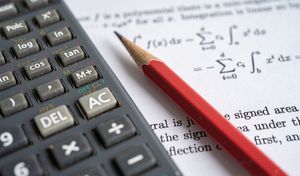Rate of Change (ROC) is a fundamental concept used in various fields, including mathematics, physics, economics, and finance. At its core, ROC measures the rate at which one quantity changes concerning another quantity, typically with respect to time. It allows us to understand the speed or direction of change in a given situation. In simpler terms, it answers questions like "How fast is something changing?" or "Is it increasing or decreasing?"
Understanding Rate of Change (ROC)
Rate of Change can be positive, negative, or zero, each revealing unique characteristics about the relationship between the two variables being observed.
Let's explore each type of ROC:
Positive Rate of Change:
A positive rate of change occurs when the value of a quantity is increasing concerning another variable. For instance, if we consider the number of customers visiting a store over time, a positive ROC would mean that the number of customers is rising consistently. In mathematical terms, when the independent variable (e.g., time) increases, the dependent variable (e.g., customer count) also increases.
Negative Rate of Change:
Conversely, a negative rate of change happens when a quantity is decreasing relative to another variable. Suppose we take the example of the temperature outside during the winter months. A negative ROC in this context would indicate that the temperature is dropping as time passes.
Zero Rate of Change:
A zero rate of change occurs when there is no change in the dependent variable concerning the independent variable. This means that the two variables are not related, or they are constant and do not affect each other. For instance, if we measure the height of a stationary object over time, we might find a zero rate of change, indicating that its height remains unchanged.
The Importance of Measuring Rate of Change
Rate of Change is a crucial concept as it helps us understand the dynamics of various phenomena. Here are some reasons why measuring ROC is essential:
- Trend Analysis: ROC allows us to identify trends and patterns in data. By analyzing the rate at which specific variables change, we can make predictions and informed decisions.
- Evaluating Performance: In business and economics, measuring the rate of change in sales, revenue, or production can help assess the performance of a company or industry.
- Scientific Insights: Rate of Change plays a vital role in scientific research. Whether it's studying population growth, chemical reactions, or climate change, ROC provides valuable insights.
- Investment Decisions: In finance, ROC is utilized to analyze investment opportunities. It helps traders and investors determine the momentum and potential profitability of various assets.
The Price Rate of Change Indicator
One of the essential tools in financial analysis is the Price Rate of Change (PROC) indicator. PROC is primarily used to analyze the rate at which the price of a financial asset changes over time. It is a momentum oscillator and helps traders identify potential buying and selling opportunities in the market.
The PROC formula calculates the percentage change in the asset's price over a specified period. For instance, if the PROC for a stock is +5%, it means the stock's price has increased by 5% over the chosen period. Conversely, a PROC of -3% indicates a 3% decrease in price.
What Are Other Terms for Rate of Change?
In different fields, Rate of Change may be referred to by other names, often indicating the specific context in which it is used. Here are some alternative terms for ROC:
- Slope: In mathematics, ROC is synonymous with the slope of a line on a graph, representing how steep or flat the line is.
- Velocity: In physics, ROC is related to velocity, which measures the change in an object's position concerning time.
- Growth Rate: In economics and finance, ROC is often referred to as the growth rate when analyzing changes in economic indicators or stock prices.
How Do You Solve Rate of Change Problems?
Solving Rate of Change problems involves following specific steps to find the ROC between two variables or data points. Let's outline the process:
- Identify the Variables: Determine which variables are changing concerning each other. For example, if you're measuring the growth of a plant over time, time is the independent variable, and plant height is the dependent variable.
- Choose Two Data Points: Select two specific data points for which you want to calculate the ROC. The points should be distinct and representative of the trend.
- Calculate the Change in the Dependent Variable: Subtract the initial value of the dependent variable from its final value to find the overall change.
- Calculate the Change in the Independent Variable: Similarly, subtract the initial value of the independent variable from its final value.
- Divide the Dependent Change by the Independent Change: Divide the change in the dependent variable by the change in the independent variable to get the ROC.
- Interpret the Result: Analyze the sign and magnitude of the ROC. A positive value indicates growth, a negative value indicates decline, and zero means no change.
How Do Traders Use the Price Rate of Change Indicator?
Traders and investors use the Price Rate of Change indicator to gain insights into the momentum and potential direction of a financial asset's price. Here's how traders use PROC:
- Trend Confirmation: When the PROC is positive and rising, it confirms an upward price trend, suggesting a potential bullish market.
- Trend Reversals: A declining PROC may indicate a potential trend reversal, where the asset's price could change direction.
- Overbought and Oversold Conditions: Traders use PROC to identify overbought and oversold conditions in the market. If the PROC is extremely high, it might indicate an overbought market, while a very low PROC might suggest an oversold market.
- Divergence: Traders look for divergences between the price of the asset and the PROC. Divergence can signal a potential change in trend.
Applications of Rate of Change Formula
The Rate of Change formula finds applications in various real-world scenarios:
- Population Studies: Demographers use ROC to analyze population growth rates and predict future population trends.
- Engineering and Physics: In engineering and physics, ROC helps analyze the speed and acceleration of objects, allowing for the design of efficient machines and understanding physical phenomena.
- Economics and Finance: ROC is widely used in analyzing economic indicators, stock prices, and financial market trends.
- Environmental Studies: ROC plays a crucial role in monitoring and understanding environmental changes, such as deforestation rates or temperature fluctuations.
- Healthcare: Medical researchers use ROC to study changes in health indicators over time, helping in disease diagnosis and treatment evaluation.
Conclusion
In conclusion, the concept of Rate of Change is a versatile and valuable tool used across multiple disciplines. Whether it's understanding the dynamics of financial markets or predicting environmental trends, ROC provides us with valuable insights into the ever-changing world around us. By learning to interpret and calculate ROC, we gain the ability to make informed decisions and understand the driving forces behind various phenomena.

FAQs - Rate of Change (ROC)
What is the Rate of Change (ROC)?
Rate of Change (ROC) is a fundamental concept used in various fields that measures the rate at which one quantity changes concerning another quantity, typically with respect to time. It helps us understand the speed or direction of change in a given situation, answering questions like "How fast is something changing?" or "Is it increasing or decreasing?"
What are the different types of Rate of Change?
ROC can be positive, negative, or zero, each indicating unique characteristics about the relationship between the two variables being observed. Positive ROC means the value of a quantity is increasing concerning another variable, negative ROC indicates a decrease, and zero ROC implies no change or independence between the variables.
How is the Price Rate of Change (PROC) indicator used in finance?
The Price Rate of Change (PROC) is a crucial tool in financial analysis. It helps traders identify potential buying and selling opportunities in the market by analyzing the rate at which the price of a financial asset changes over time. A positive PROC confirms an upward price trend, while a negative PROC may signal a potential trend reversal.
What are other terms for Rate of Change?
Rate of Change may be referred to by other names in different contexts. In mathematics, it is synonymous with "slope." In physics, it is related to "velocity," measuring the change in an object's position concerning time. In economics and finance, ROC is often referred to as the "growth rate" when analyzing changes in economic indicators or stock prices.
How can I calculate Rate of Change between two variables?
To calculate the Rate of Change between two variables, follow these steps: identify the variables, choose two data points, calculate the change in the dependent and independent variables, divide the dependent change by the independent change, and interpret the result. A positive value indicates growth, a negative value indicates decline, and zero means no change.






